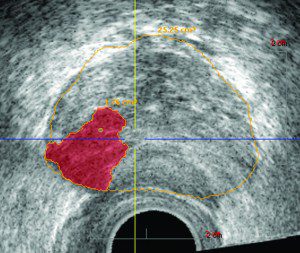 According to the American Cancer Society, an estimated 225,000 new cases of prostate cancer occurs annually in the U.S. It is the most frequently diagnosed cancer in men, aside from skin cancer. With an estimated 30,000 deaths per year, prostate cancer is the second-leading cause of cancer death in men.
According to the American Cancer Society, an estimated 225,000 new cases of prostate cancer occurs annually in the U.S. It is the most frequently diagnosed cancer in men, aside from skin cancer. With an estimated 30,000 deaths per year, prostate cancer is the second-leading cause of cancer death in men.
Prostate cancer is a disease in which malignant (cancer) cells form in the tissues of the prostate. Normally, cells within the prostate grow, divide, interact, and die to make sure the prostate functions properly. Normal prostate cells become cancerous when this process is disrupted. This disruption causes cells to lose control and grow on top of each other, thus forming a tumor.
Signs and Symptoms
Early-stage prostate cancer may not be associated with any obvious signs or symptoms and, often times, symptoms can be mistaken for those of other disorders. Most cases of prostate cancer are not detected until they have spread out of the prostate and begin to cause noticeable symptoms.
Some of these symptoms may include:
• Loss of appetite and weight
• Frequent need for urination
• Difficult of painful urination
• Blood in the urine
• Painful ejaculation
• Bone pain
• Pelvic pain
Early Detection
Thanks to new technology, prostate cancer is being detected and treated earlier, before it can spread to other tissues. The earlier prostate cancer is detected, the more easily it can be treated.
Emerging technology with MRI is available at Advanced Imaging.
MRI is an emerging tool for possible early detection of prostate cancer and other prostate-related conditions. MRI uses radiofrequency waves to create a detailed cross-sectional image of the prostate and surrounding tissues.
Prostate MR uses advanced magnetic resonance imaging to create very accurate and clear images of the prostate gland. These images are diagnostic quality and can be useful when diagnosing possible prostate diseases. Medical images resulting from prostate MR can be combined with powerful post-
processing computer programs to provide detailed information about the prostate. This information can offer a wider variety of diagnosis and treatment options for clinicans and patients. If you feel you could benefit from a prostate MRI please discuss with your physician.
Images provided from MR, however, do not always indicate cancer. Prostate MR images identify specific regions of the gland that may appear suspicious and can be further evaluated through a targeted MR-guided biopsy procedure. MRI of the prostate can also be used to evaluate other prostate conditions, including prostatitis (inflammation of the prostate) and benign prostatic hyperplasia (BPH)(enlargement of the prostate).
MR-guided biopsies may be helpful to patients who have had several sessions of TRUS-guided biopsies with negative results. Compared to published cancer yield rates of up to 15% greater with their TRUS-guided biopsies, the increased rate of detection may give greater confidence to both physicians and patients.
Benefits:
• Prostate MRI is a noninvasive imaging technique that does not require exposure to ionizing radiation.
• Prostate MRI provides clear and detailed images of the soft-tissue structures of the prostate that may not be assessed adequately with other imaging methods such as x-ray, ultrasound or computed tomography (also called CT or CAT scanning). The detail makes MRI a helpful tool in early diagnosis and evaluation of tumors.
• Prostate MR images can help physicians evaluate the function as well as the structure of many organs.
• MRI contrast material is less likely to produce an allergic reaction than the iodine-based materials used for conventional x-rays and CT scanning.
For more information about early detection of Prostate Cancer, contact Advanced Imaging at 941-235-4646 or visit our website at advimaging.com.







